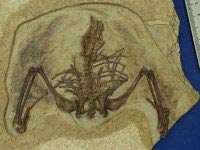Strange 100-Million-Year-Old Fossils Found in China with Bones, Feathers, and Flesh Pads on the Feet Prove That Modern Birds Evolved from Aquatic Birds.
 |
|
Reconstructed image of the ancient amphibious bird Gansus yumenensis – the most advanced bird species discovered from the early Cretaceous period. (Image: Mark A. Klingler/CMNH) |
Dr. Peter Dodson, a professor of anatomy at the University of Pennsylvania (USA), along with colleagues, reported the discovery of five incomplete skeletons found 2,000 kilometers west of Beijing.
Known as Gansus yumenensis, this pigeon-sized bird resembles a sea swallow or diving bird (species that have webbed feet and are fish-eaters).
Scientists believe it was a creature capable of both flying and diving, and it may represent one of the ancestors of modern birds.
“Gansus is very close to modern birds and fills the gap between clearly ancient birds and the explosion of bird species at the beginning of the Cretaceous period, the last era of the dinosaurs, 100 million years ago,” Dodson stated.
He noted that Gansus is the oldest example of a near-modern bird, branching from a family tree with the famous ancestor Archaeopteryx – a species that evolved from dinosaurs.
 |
|
Almost complete fossil of a Gansus. (Image Hai-lu You/CAGS) |
“All living bird species today, from African ostriches to bald eagles, may have evolved from a common ancestor resembling Gansus</em," a member of the research team remarked.
The five skeletons date back between 115 and 105 million years. None of them had heads, but the wings, legs, and flesh pads on the feet of the specimens closely resemble those of diving birds and ducks alive today, with a few differences.
These creatures did not have the lightweight, hollow bones that make modern birds agile; they still possessed tiny claws at the wing tips – features that may have made them less adept at flying.
T. An


















































